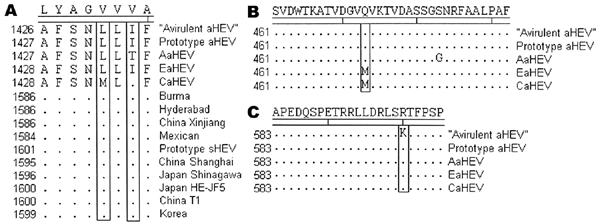Volume 16, Number 9—September 2010
Dispatch
Analysis of Avian Hepatitis E Virus from Chickens, China
Figure 1

Figure 1. Amino acid sequence comparison of motif VII in the open reading frame (ORF) 1 RNA-dependent RNA polymerase (RdRp) region of avian, human, and swine hepatitis E viruses (HEVs) (A), antigenic domain II (B), and antigenic domain IV (C) in the ORF2 region of avian HEV. Residues that are conserved among avian HEV (aHEV) isolates are shown as the consensus above the sequences; residues that are conserved in the HEV strains are not shown. GenBank accession numbers of human and swine HEV (sHEV) strains are M73218 (Burma), AF076239 (Hyderabad), D11092 (China Xingjiang), M74506 (Mexico), AF082843 (prototype sHEV), FJ527832 (China Shanghai), AB291955 (Japan Shinagawa), AJ272108 (China T1), AB480825 (Japan HE-JF5), and FJ763142 (Korea). GenBank accession numbers of avian HEV strains are EF206691 (“avirulent aHEV” from the United States), AM535004 (prototype aHEV from the United States), AM943647 (aHEV from Australia [AaHEV]), AM943646 (aHEV from Europe [EaHEV]), and GU954430 (aHEV from China [CaHEV]). Boxes indicate mutations of CaHEV compared with different HEV strains.
1Current affiliation: Northwest A&F University, Yangling, People’s Republic of China.